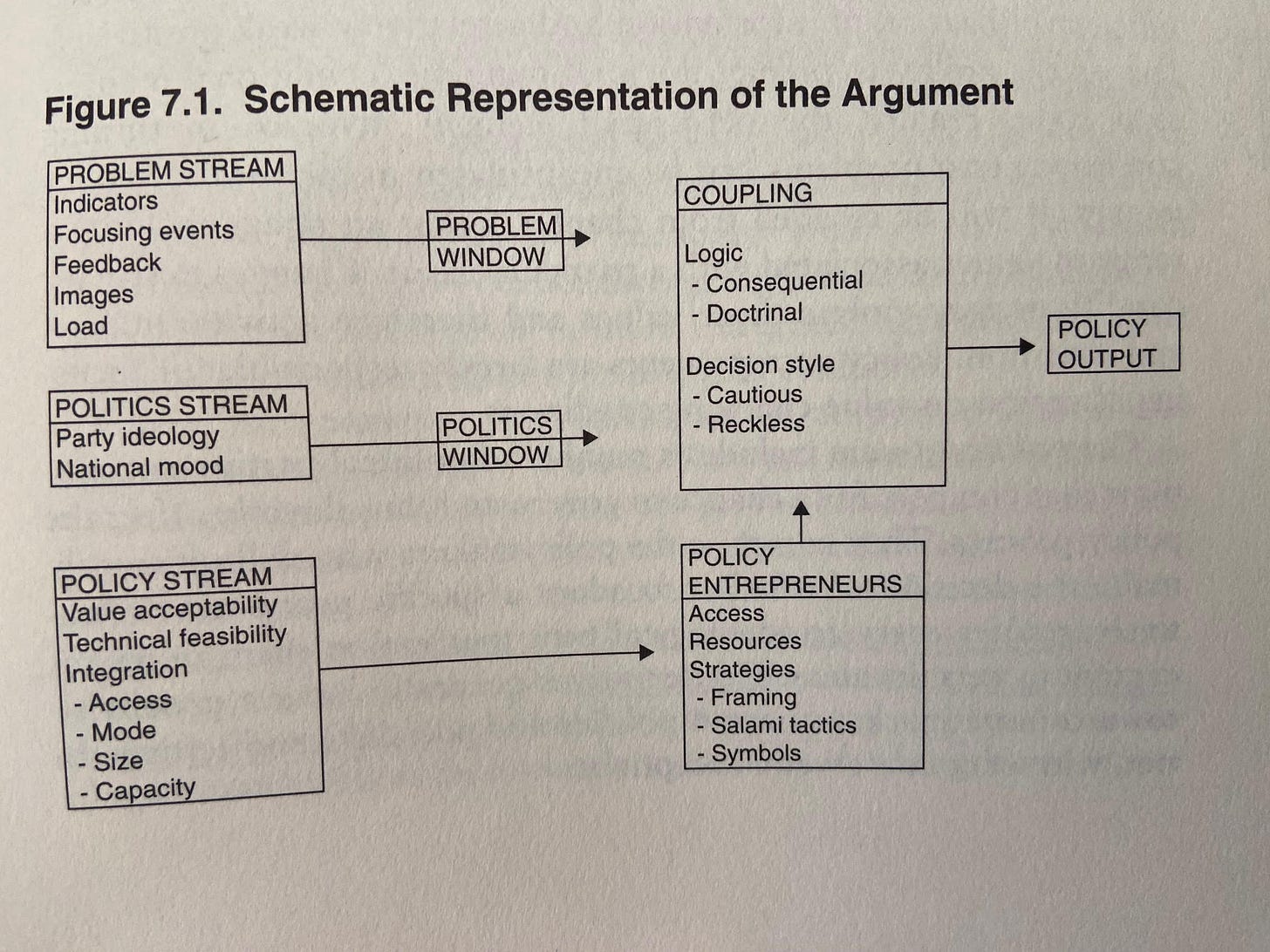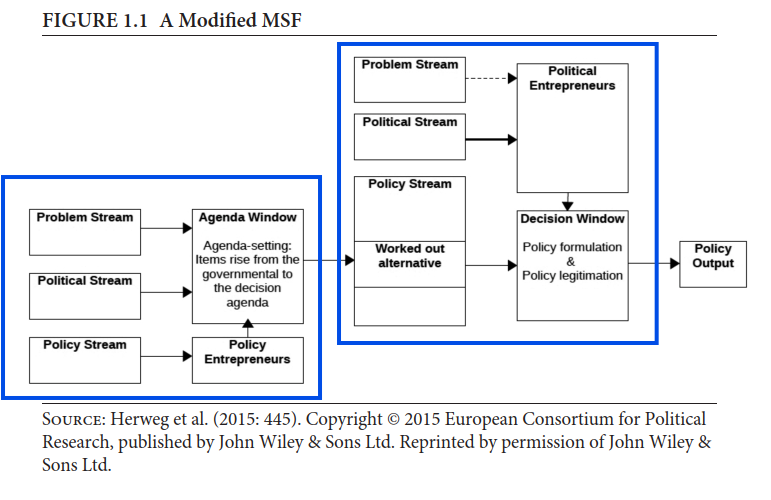The Power of Process: Alternative Perspectives on Kingdon's Multiple Streams Framework
Contemporary visualizations of the MSF highlight five "structural elements." These are totally compatible with an alternative view that highlights four "processes." Let me explain.

In an era of reduced government staffing and tightening budgets, how we visualize policy frameworks matters more than ever. Different representations of Kingdon's Multiple Streams Framework don't just reflect academic preferences—they shape how policy analysts understand policy change and where they focus their limited resources. Is your mental model of policy change helping or hindering your effectiveness?
When Visualization Choice Matters: A Capitol Hill Example
Imagine two legislative staffers analyzing why a bipartisan criminal justice reform bill stalled despite widespread support. The first staffer, using the traditional five-element MSF visualization, concludes: "We had the right champion and a solid bill, but the timing was off politically. We should wait for the midterms or find someone with more pull." This diagnosis suggests waiting for better political timing or finding a more influential champion.
The second staffer, using a process-focused visualization, offers a different insight: "We need to reframe how we're connecting this to current issues. Our messaging isn't clicking with what voters care about right now or how leadership is thinking about priorities." This diagnosis suggests immediate action: reframing the solution to better align with both problem definitions and political realities.
Same theory, different visualizations, different actionable insights.
This isn't just theoretical—it reflects how the mental maps we use shape both our analysis and our responses. And in today's resource-constrained policy environment, choosing the right visualization for your purpose can be the difference between effective action and spinning your wheels.
Maps and Territories: Why Visualization Matters
At its core, a theoretical visualization is like a map. Just as different maps of the same city might highlight streets, land cover, or voting districts, different MSF visualizations emphasize different aspects of the policy process while accurately representing Kingdon's ideas.
The purpose of any conceptual framework visualization is to clarify a theory's logic by simplifying it for a particular purpose. This is a critical point that's often overlooked.
Consider this analogy: When building a house, architects create multiple views—floor plans, elevations, electrical diagrams, plumbing schematics. Each serves a different purpose while representing the same physical structure. The electrical engineer needs different information than the interior decorator, even though they're working on the same house.
Similarly, different policy actors might need different visualizations of the MSF, depending on whether they're analyzing past policy changes, planning strategic interventions, or teaching newcomers about policy dynamics.
The Evolution of MSF Visualizations: From Text to Image
Kingdon wrote an entire book to explain his groundbreaking framework in 1984, but the transformation of his ideas into visual form was revolutionary for how we understand policy change.
The first published MSF visualization came from Nikolaos Zahariadis in 2003:

This "schematic representation" included eight boxes—more complexity than today's standard visualization. Notably, it included a structural element called "COUPLING" that later visualizations de-emphasized or subsumed.
Over time, the visualization evolved into what we now recognize as the five-element standard:
Problem Stream
Policy Stream
Politics Stream
Policy Entrepreneurs
Policy Windows
Through successive iterations (2007, 2018, and beyond), these five elements remained central, though their arrangement and internal details shifted:
The 2018 two-window extension by Herweg, Zahariadis, and Zohlnhofer expanded the model to distinguish between agenda-setting and decision-making phases:

This evolution reflects how visualizations adapt to serve different analytical needs while maintaining the core insights of the theory.
Alternative View: Four Processes Instead of Five Elements
While the five-element visualization has become standard, my research with Sonja Blum suggests an alternative, process-focused visualization that highlights four key processes:
This process-focused visualization shifts attention from static elements to dynamic interactions. Let me explain each of the four processes:
1. Problem Stream Process
Rather than viewing conditions in binary terms, as either problematic or not, the problem stream process involves the continuous identification, framing, and attending to issues. This process includes:
How issues get attention through indicators, focusing events, and feedback
How problems are defined and categorized by different stakeholders
How problems rise and fall in prominence
How problem definitions shift over time
For practitioners, understanding this as a process means actively managing problem definition rather than just responding to "given" problems.
2. Policy Stream Process
The policy stream isn't just a pool of ideas but an ongoing process of solution development, refinement, and evaluation. This process encompasses:
How policy communities generate and refine ideas
How solutions evolve through professional networks
How proposals are evaluated against criteria like technical feasibility, value acceptability, and robustness to future constraints (budgetary, political, etc.)
How certain solutions gain support while others fade away
For practitioners, this process view emphasizes continuous proposal development rather than one-time solution crafting.
3. Political Stream Process
The political stream involves the dynamic flow of political factors that create favorable or unfavorable conditions for policy change. This process includes:
How public mood shifts and crystallizes, before shifting again
How organized interests consolidate into forces that reform and evolve
How electoral and administrative transitions create opportunities
How partisan dynamics affect receptivity to different types of proposals
For practitioners, seeing politics as a process means actively monitoring and responding to shifts rather than treating political conditions as fixed constraints.
4. Coupling Process
In our 2023 book chapter, "The beating heart of the Multiple Streams Framework: Coupling as a process," Sonja Blum and I argue that coupling deserves renewed attention as a central process, not just an outcome of the three streams meeting. Coupling is the process where advocates called policy entrepreneurs actively connecting problems, policies, and politics through:
Strategic framing that links viable solutions to salient problems
Tactical timing that leverages political opportunities
Narrative construction that ensures compatibility between problem definitions and proposed solutions
Coalition building that aligns diverse stakeholders around a common approach
Coupling isn't just what happens when streams meet—it's an active, intentional process that skilled policy actors perform continuously.
This four-process framework emphasizes that policy change emerges from dynamic interactions rather than static conditions or momentary alignments. It highlights that policy actors can influence these processes even when they can't control structural elements like who the entrepreneurs are or when windows open.
These aren't just academic differences - they lead to meaningfully different approaches to policy work. A staffer who sees policy through the 5-element lens might focus on different strategies and opportunities than one who sees it through the 4-process lens, even when facing identical situations.
Why Process Focus Matters for Policy Practitioners
For busy Congressional staffers and policy professionals facing today's challenges of reduced staffing and budget constraints, a process-focused visualization offers several practical advantages:
Actionable Leverage Points: Processes are often easier to modify than structural elements. You can improve how you connect issues to solutions even when you can't control external events or change who's in charge.
Resilience in Resource-Constrained Environments: Understanding processes helps maintain policy momentum even when resources are limited. When staff are cut and budgets tightened (as they have been recently), process knowledge helps you do more with less.
Strategic Communication: Process knowledge helps you frame issues effectively at each stage, ensuring you're speaking the right language to the right audience at the right time.
Adaptability: Process focus highlights how policy dynamics can continue functioning under changing conditions, even when traditional structures are disrupted.
This perspective gives practitioners tools to work within existing constraints rather than waiting for ideal conditions that may never arrive.
Keep reading with a 7-day free trial
Subscribe to Views Through a Policy Prism to keep reading this post and get 7 days of free access to the full post archives.






